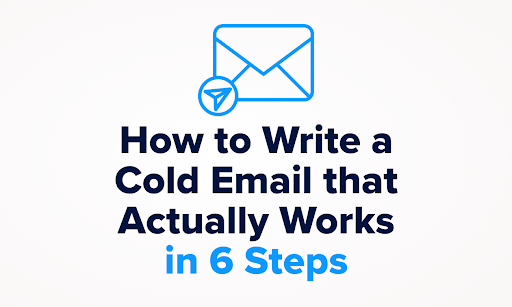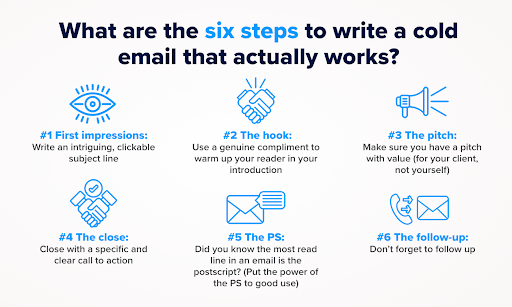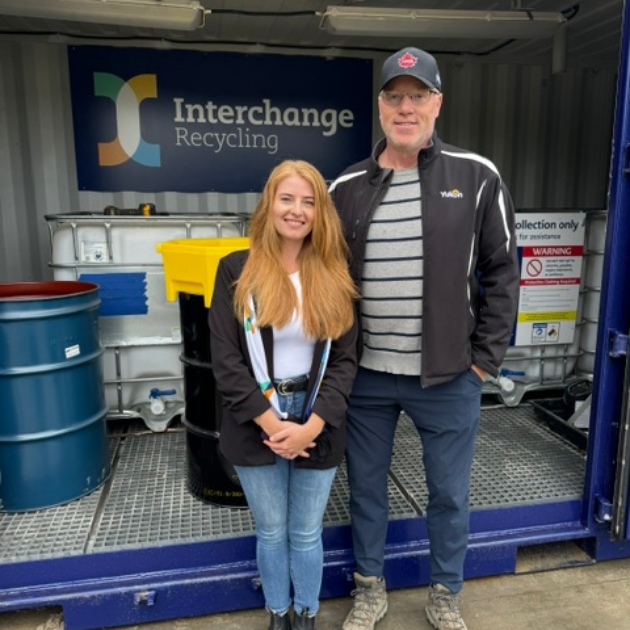How to write a cold email that actually works in 6 steps
Writing cold emails that get a response is possible—if done effectively.

Crickets.
Is that what happens when you send emails to prospective clients?
Does that mean sending cold emails doesn’t work?
“I ignore 99% of the thousands of emails I receive every week.”
—said every business owner, ever.
Face it, business owners are inundated with multiple messages every day and don’t have the time or interest to read your cold email—unless it has something that can make their job easier, or improve their life.
The good news is writing cold emails that get a response is possible—if done effectively.
Before we dive into how to write effective emails, let's look at how 99% of emails are written so you don’t make the same mistakes.
Emails that are guaranteed to flop
- Use the same subject line for every email. e.g. Hi, it’s {your_name} from {your_company}
- Start talking about how great you are in the first sentence.
- Continue every sentence thereafter with the letter “I”. e.g. “I know you will love our company because we have the best blah, blah blah…”
- Use the word “should” in your close. e.g. “You should call me back right away at xxx-xxx-xxxx to get this must-have deal.”
- Begin by composing your message in your email app and hitting send without much thought.
- Forget to follow up.
How to write a cold email that actually works in six steps
- First impressions: Write an intriguing, clickable subject line
- The hook: Use a genuine compliment to warm up your reader in your introduction
- The pitch: Make sure you have a pitch with value (for your client, not yourself)
- The close: Close with a specific and clear call to action
- PS: Do you know the most read line in any email? (Hint: re-read this line)
- The follow-up: Don’t forget to follow up.
Here are the six steps of writing effective emails in a little more detail with examples.

Step 1—First impressions: Write an intriguing subject line
You have 7-14 words to entice a prospective reader to click on your email, so you better make them count. Here’s how:
- Use the email recipient's first name as the first or second word in the subject line
Using a personal name in the subject line is the single most effective way to have your email opened, read and considered.
- Follow up with a clear benefit preferably using a question.
Questions engage the recipient and get them to pause instead of skimming past.
Subject line examples:
- Hey, {FIRST NAME} Would you like to learn a [better/smarter/faster] way to [reach a specific goal]
- Hi, {FIRST NAME} are you interested in improving X?
- Hi, {FIRST NAME} have you thought about switching X?
What is the best length for a subject line? Campaign Monitor recommends a subject line of 41 characters so that each word appears on desktop, mobile, and tablet devices.
Step 2—The hook: Use a genuine compliment to warm up your reader in your introduction
Instead of introducing yourself or your company, the best way to catch someone's attention is to share a genuine compliment on something they care about. That shows you have taken the time to learn about their needs. This can be done in one or two sentences.
Hook example:
- Hi {first_name}, I’ve just read your {website /social_media_post} about {specific topic} and appreciated {one_thing_that_you_especially_liked}
- Hello, {first_name}, I’m reaching out because I saw your Instagram post of {an_endorsement_from_a_user}—wow, what a great endorsement!
- Hi {first_name} I’m reaching out because I saw this excellent 5-star google review about your business: {“quote_part_of_the_excellent_review”}.
- Hi {first_name} I’m reaching out because I noticed that {name of their company} is celebrating your 10th anniversary with a big sale. One decade in business—congratulations!
Step 3—The pitch: Include something of value
Avoid salesy pitches. Instead, put yourself in your customer's shoes. Find out what problems they may face that you can help them with. Use storytelling to show them how you might relieve them of those problems.
Your pitch should also be seamlessly linked to the previous part of your email. Make it seem like a natural continuation of an ordinary conversation.
A good way to do this is to reference how you’ve helped others in a similar situation and the results they received from working with you. Then help your client visualize having similar results for their business.
Step 4—The close: Close with a specific and clear call to action
Make the next step you would like your recipient to take clear and easy to do. Because this is a cold call that may never have heard of you or your company, don’t expect the next step to purchase your service. Instead, invite your prospect to learn more. Also, don’t confuse your prospect with several CTAs (call-to-action).
CTA example:
Do you have 15 minutes to video chat this week? Book a chat on my google calendar with the time that works best for you. (Or simply reply to this email with your preferred time)
Step 5—PS: Do you know the most read line in any email? (Hint: re-read this line)
Over 90% of people read the P.S. before the email message!
Why not put that power to use by always including a short postscript message in your email? Use it to create a sense of urgency or to share a FOMO message.
Step 6—The follow-up: Don’t forget to follow up
A non-response doesn’t always mean your recipient isn’t interested. Sometimes it only means they didn’t have time to reply.
One follow-up email is a must in your cold email strategy, but the optimal number is two or three. Try not to treat follow-ups like reminders that you’re awaiting the prospect’s response. Sneak some extra value in them: link to an interesting case study or give them another reason to learn more.
The best way to follow up is to resend the original email with a short one or two-sentence reply.
Follow-up example:
Subject: re:{original_subject_line}
Hi again {first_name} I’m following up to see if we could carve out a few minutes to show you how you could {value_statement}. Or if you prefer to text, hit me up with a short message letting me know your name and what you would like to know more. My text is xxx-xxx-xxxx
{Original_email_message_here}
The bottom line
No, email can’t replace face-to-face or virtual video meetings, but emails are still the most common form of communication for business decision-makers. Speaking as someone who gets hundreds of email pitches every week and ignores 95% of those emails I can say that have responded to cold email pitches if they are short, to the point and most importantly share something that promises to help make my job easier.
What is your biggest marketing challenge right now?
Why not try out your new-found email writing skills and send the Branding Geek an email and share your biggest marketing challenge? I love helping businesses like yours navigate the world of digital marketing and would be willing to share one thing that can help you get more leads and bookings for your business.





Comments